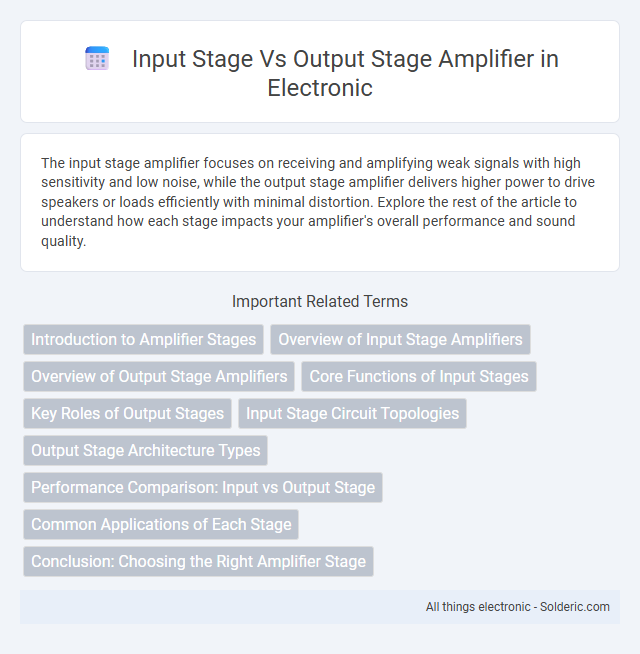The input stage amplifier focuses on receiving and amplifying weak signals with high sensitivity and low noise, while the output stage amplifier delivers higher power to drive speakers or loads efficiently with minimal distortion. Explore the rest of the article to understand how each stage impacts your amplifier's overall performance and sound quality.
Comparison Table
| Feature | Input Stage Amplifier | Output Stage Amplifier |
|---|---|---|
| Primary Function | Amplifies weak input signals | Drives load with amplified output signal |
| Signal Level | Low-level signals | High-level signals |
| Impedance | High input impedance | Low output impedance |
| Power Handling | Low power | High power |
| Noise Sensitivity | Highly sensitive to noise | Less sensitive to noise |
| Common Transistor Types | BJT, FET (e.g., MOSFET input stage) | Power BJTs, MOSFETs |
| Role in Amplifier Design | Signal conditioning and initial amplification | Final amplification and load driving |
| Voltage Gain | High voltage gain | Moderate voltage gain |
| Current Gain | Low current gain | High current gain |
Introduction to Amplifier Stages
The input stage amplifier primarily handles weak signal reception and initial amplification, ensuring low noise and high input impedance. The output stage amplifier focuses on delivering maximum power to the load with low output impedance and high current capability. These stages work in tandem to optimize signal fidelity and overall amplification efficiency.
Overview of Input Stage Amplifiers
Input stage amplifiers primarily serve to receive and condition the initial electrical signal, ensuring minimal noise and distortion while providing sufficient gain. They are designed to offer high input impedance to protect signal sources and maintain signal integrity. Your choice of input stage amplifier directly impacts the overall performance and fidelity of the entire amplifier system.
Overview of Output Stage Amplifiers
Output stage amplifiers serve as the final amplification step in electronic circuits, driving the load with sufficient power and current. They are designed to handle higher voltage and current levels compared to input stages, ensuring efficient signal delivery to speakers, motors, or other devices. Your system's performance and sound quality largely depend on the output stage's ability to minimize distortion and maximize power transfer.
Core Functions of Input Stages
Input stages in amplifiers serve as the critical interface for signal reception, providing initial voltage amplification while maintaining high input impedance to prevent signal loss. These stages enhance signal fidelity by minimizing noise and distortion, setting the foundation for overall amplifier performance. Understanding the core functions of your amplifier's input stage ensures optimal signal accuracy before it reaches the output stage for power amplification.
Key Roles of Output Stages
The output stage of an amplifier plays a critical role in delivering the amplified signal to the load with minimal distortion and maximum power efficiency. It ensures proper impedance matching between the amplifier and the speaker or other output devices, optimizing signal transfer. Your audio system's overall performance heavily depends on the output stage's ability to handle high current drive and maintain signal fidelity under varying load conditions.
Input Stage Circuit Topologies
Input stage circuit topologies in amplifiers primarily include common emitter, common base, and common collector configurations, each offering distinct input impedance and gain characteristics. The common emitter topology provides high voltage gain and moderate input impedance, making it suitable for voltage amplification, while common collector offers high input impedance and unity gain, ideal for buffering applications. Choosing the appropriate input stage affects your amplifier's overall performance, noise level, and linearity before driving the output stage.
Output Stage Architecture Types
Output stage amplifier architecture types include Class A, Class B, Class AB, and Class D, each offering distinct trade-offs in efficiency, linearity, and complexity. Class A output stages provide high linearity with low distortion but have poor efficiency, while Class B stages improve efficiency but suffer from crossover distortion. Class AB output stages balance linearity and efficiency, making them common in audio applications, and Class D amplifiers use pulse-width modulation for high efficiency, ideal for power-sensitive designs.
Performance Comparison: Input vs Output Stage
The input stage of an amplifier primarily determines the signal integrity and noise performance, ensuring minimal distortion and maintaining high input impedance for optimal signal reception. The output stage is designed to deliver sufficient power to the load, focusing on driving capability and efficiency, often with lower impedance to handle higher current demands. Your amplifier's overall performance depends on the balanced design of both stages, where the input stage ensures signal fidelity and the output stage provides robust power delivery.
Common Applications of Each Stage
Input stage amplifiers are commonly used in preamplifiers and sensor interfaces to provide initial signal amplification and impedance matching. Output stage amplifiers are typically found in power amplifiers and audio amplifiers, where they deliver high current or voltage gain to drive speakers or loads. Each stage plays a critical role in ensuring signal integrity and proper power delivery in audio and electronic systems.
Conclusion: Choosing the Right Amplifier Stage
Input stage amplifiers primarily handle low-level signals by providing voltage gain with minimal noise, making them essential for accurate signal processing. Output stage amplifiers deliver high current and power to drive speakers or loads efficiently, emphasizing reliability and distortion control. Your choice depends on whether you need precise signal amplification or robust power delivery for optimal audio performance.
input stage vs output stage amplifier Infographic

 solderic.com
solderic.com